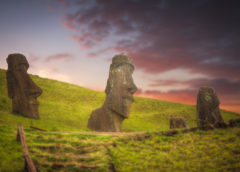They may have solved a mystery on Easter Island. Most of us have heard of Easter Island, or Rapa Nui in the local language, with its towering heads statues made of stone, and the mystery surrounding them.
Easter Island (Rapa Nui: Rapa Nui, Spanish: Isla de Pascua) is a Chilean island in the southeastern Pacific Ocean, at the southeasternmost point of the Polynesian Triangle in Oceania. Easter Island is most famous for its nearly 1,000 extant monumental statues, called moai, created by the early Rapa Nui people. In 1995, UNESCO named Easter Island a World Heritage Site, with much of the island protected within Rapa Nui National Park. (wikipedia)
Why were these statues placed in these various locations on the island?
Some researchers may have come up with an explanation.
They may have solved a mystery on Easter Island
Most of us have heard of Easter Island, or Rapa Nui in the local language, with its towering heads made of stone, and the mystery surrounding them.
Why were these statues placed in these various locations on the island?
Some researchers may have come up with an explanation. They theorize that the location and size of the moai and the raised platform on which they sit, called ahu, indicate the presence of freshwater on the island. The different statue sizes may correspond to the quantity and freshness of the water.
The researcher’s report is in the peer reviewed journal, PLOS ONE (Public Library of Science).
Other researchers, however, say that this theory is open to conjecture and are waiting for more evidence linking water sources with the statues.

Rod is a blogger, writer, filmmaker, photographer, daydreamer who likes to cook. Rod produces and directs the web series, CUPIC: Diary of an Investigator. He is also the editor, producer and administrator of STM Daily News, a part of the TNC Network.

